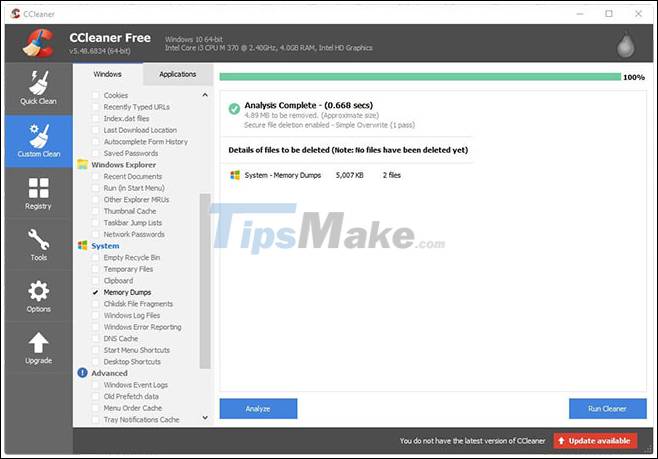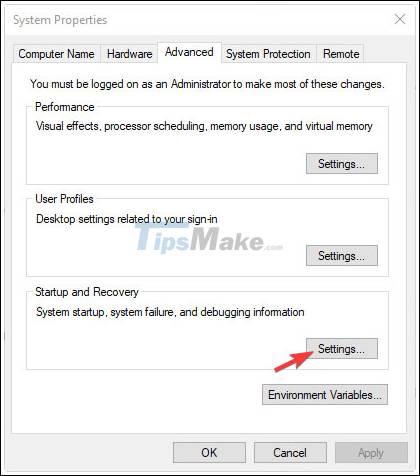How to delete memory dump files in Windows
Memory dumps, in other words crash dumps, are system files that were saved during the blue screen of death. When the BSOD error message appears, Windows saves a copy of the system memory.
The crash dump files can then be used to assist developers in fixing BSOD system errors. User can send crash dump to developers when requesting support.
Memory dump files can waste a lot of hard drive space. They can take up many gigabytes of hard drive storage. Windows only automatically deletes crash dump files when hard drive space is limited. However, users can also delete crash dump with cleaning utilities.
1. Delete crash dump with Disk Cleanup
You can delete crash dump using Windows' Disk Cleanup tool. To do that, launch Run using the Windows + R keyboard shortcut .
Type cleanmgr in Run 's Open text box .
Press Ctrl + Shift + Enter to open Disk Cleanup as admin.
Select drive C: on the Drive selection window and click the OK button .

Select the checkbox System error memory dump files .
Then click the OK button .
If users cannot find the option System error memory dump files in Disk Cleanup, open the utility through the Command Prompt with admin rights. Import:
%SystemRoot%System32Cmd.exe /c Cleanmgr /sageset:16 & Cleanmgr /sagerun:16. in the Command Prompt and press Enter . This will open Disk Cleanup with more checkbox options.
2. Delete crash dump with CCleaner
In addition, users can delete crash dump with free CCleaner software. To do that, download CCleaner first. Follow the instructions in its setup wizard. Launch the CCleaner utility.
Select Custom Clean on the left side of CCleaner.

Then select the Memory Dumps checkbox .
Click the Analyze button .
Select the Run Cleaner option to clear the crash dump.
3. Delete crash dump via Command Prompt
You can also delete crash dump with a series of Command Prompt commands. To do so, open Run.
Type cmd in Run and press Ctrl + Shift + Enter .
Then, type the following separate commands into the Command Prompt and press Enter after each one:
fsutil usn deletejournal /d /n c: del '%temp%*' /s /f /q del 'C:$Recycle.bin*' /s /f /q del '%systemroot%temp*' /s /f /q vssadmin delete shadows /for=c: /all /quiet Dism /Online /Cleanup-Image /StartComponentCleanup /ResetBase4. Turn off crash dump
Users can turn off crash dump to ensure they don't take up extra storage space on HDD. Type Control Panel in Run 's Open text box and press Enter.
Then click System to open the Control Panel application shown right below.
Click Advanced system settings on the left side of the window to open the Advanced tab .
Then click the Settings button in Startup and Recovery.

Select the (none) option on the drop-down menu shown directly below to disable crash dump.
Then click the OK button .
You should read it
- How to Read Dump Files
- Analysis of Memory Dump file (* .dmp)
- What is DMP file? How to open DMP files in Windows 10
- 3 ways to configure BSOD crash dump on Windows
- What is a .tmp file? How to open .tmp file on Windows computer?
- Create Backup in MongoDB
- How to delete repeat file to save computer memory by CCleaner
- Compress hiberfil.sys file to free up disk space on Windows 10
May be interested
- 3 ways to configure BSOD crash dump on Windows
 a blue screen of death (bsod) usually occurs when there is a critical error and windows cannot recover or repair it. to determine the cause of the blue screen of death, you need to configure windows to create a minidump each time something goes wrong.
a blue screen of death (bsod) usually occurs when there is a critical error and windows cannot recover or repair it. to determine the cause of the blue screen of death, you need to configure windows to create a minidump each time something goes wrong. - Delete files on Mac directly without the Trash trash
 on windows operating systems, you can delete files permanently by pressing and holding the shift key. however, this is not available on mac. and wait until os x 10.11 el capitan mac users can use this feature.
on windows operating systems, you can delete files permanently by pressing and holding the shift key. however, this is not available on mac. and wait until os x 10.11 el capitan mac users can use this feature. - How to regain storage space for Chromebooks
 usually chromebook computers have limited internal memory and will quickly reach the maximum storage limit. from here, users will encounter error messages when downloading files and creating new files on the computer. it's time for users to clean up chromebooks to regain precious storage space for themselves.
usually chromebook computers have limited internal memory and will quickly reach the maximum storage limit. from here, users will encounter error messages when downloading files and creating new files on the computer. it's time for users to clean up chromebooks to regain precious storage space for themselves. - How to add trash to permanently delete files on Windows 10/11
 do you want a recycle bin on your windows 10 or 11 desktop that actually deletes files that are dragged into it and cannot be recovered? the good news is that you can do this using free file wiper and multi trash.
do you want a recycle bin on your windows 10 or 11 desktop that actually deletes files that are dragged into it and cannot be recovered? the good news is that you can do this using free file wiper and multi trash. - What is Hiberfil.sys? How to delete Hiberfil.sys?
 hiberfil.sys consumes a lot of hard drive space on your computer. hibernate uses hiberfil.sys files to store the current state (memory) of the computer, so the file hiberfil.sys is managed by windows so you cannot delete these files in a way that is clear. often.
hiberfil.sys consumes a lot of hard drive space on your computer. hibernate uses hiberfil.sys files to store the current state (memory) of the computer, so the file hiberfil.sys is managed by windows so you cannot delete these files in a way that is clear. often. - How to batch delete files on Windows 10
 deleting anything more than a few files with file explorer can become a lengthy process. when it comes to batch deletion of files on windows 10, you have a few options.
deleting anything more than a few files with file explorer can become a lengthy process. when it comes to batch deletion of files on windows 10, you have a few options. - How to Recover Photos from SD Memory Card
 did you accidentally delete some files on your sd card or lose data due to a faulty memory card? if you stop using this memory card immediately and act quickly, the files can still be recovered using data recovery software. there are free options for each operating system, as well as paid programs that are easy to use.
did you accidentally delete some files on your sd card or lose data due to a faulty memory card? if you stop using this memory card immediately and act quickly, the files can still be recovered using data recovery software. there are free options for each operating system, as well as paid programs that are easy to use. - 2 ways to permanently delete files on Windows
 normally, when deleting a file on windows, the file will not be deleted immediately but will be saved in recycle bin. after that, you will have to do one more step to clear the trash. but if you do not want to take this second step, we will guide you how to permanently delete a file in the article below. please consult.
normally, when deleting a file on windows, the file will not be deleted immediately but will be saved in recycle bin. after that, you will have to do one more step to clear the trash. but if you do not want to take this second step, we will guide you how to permanently delete a file in the article below. please consult. - How to view recently deleted files on Windows 10?
 usually when you delete any file on a windows 10 computer by right-clicking on the file and selecting delete or selecting the file then pressing the delete key, then the file will be moved to recycle bin. or another way to permanently delete files is to press shift + delete, and windows will move these files from recycle bin.
usually when you delete any file on a windows 10 computer by right-clicking on the file and selecting delete or selecting the file then pressing the delete key, then the file will be moved to recycle bin. or another way to permanently delete files is to press shift + delete, and windows will move these files from recycle bin. - Trick to delete junk files to free up space and cache iPhone, iPad
 after a period of use, you will notice that your iphone, or ipad, is getting slower and smaller, while the remaining space is too small. it's time you need to clean up your iphone, ipad by deleting unnecessary junk files to free up the occupied space.
after a period of use, you will notice that your iphone, or ipad, is getting slower and smaller, while the remaining space is too small. it's time you need to clean up your iphone, ipad by deleting unnecessary junk files to free up the occupied space.










 Increase storage on your computer with OneDriver
Increase storage on your computer with OneDriver How to List Installed Drivers in Windows (PowerShell CMD)
How to List Installed Drivers in Windows (PowerShell CMD) 5 ways to access Advanced Options on Windows 10/8 / 8.1
5 ways to access Advanced Options on Windows 10/8 / 8.1 How to record screen video on Chromebook
How to record screen video on Chromebook This tip can help you speed up the network on Windows
This tip can help you speed up the network on Windows How to pin files or folders to the 'taskbar' of your Chromebook
How to pin files or folders to the 'taskbar' of your Chromebook